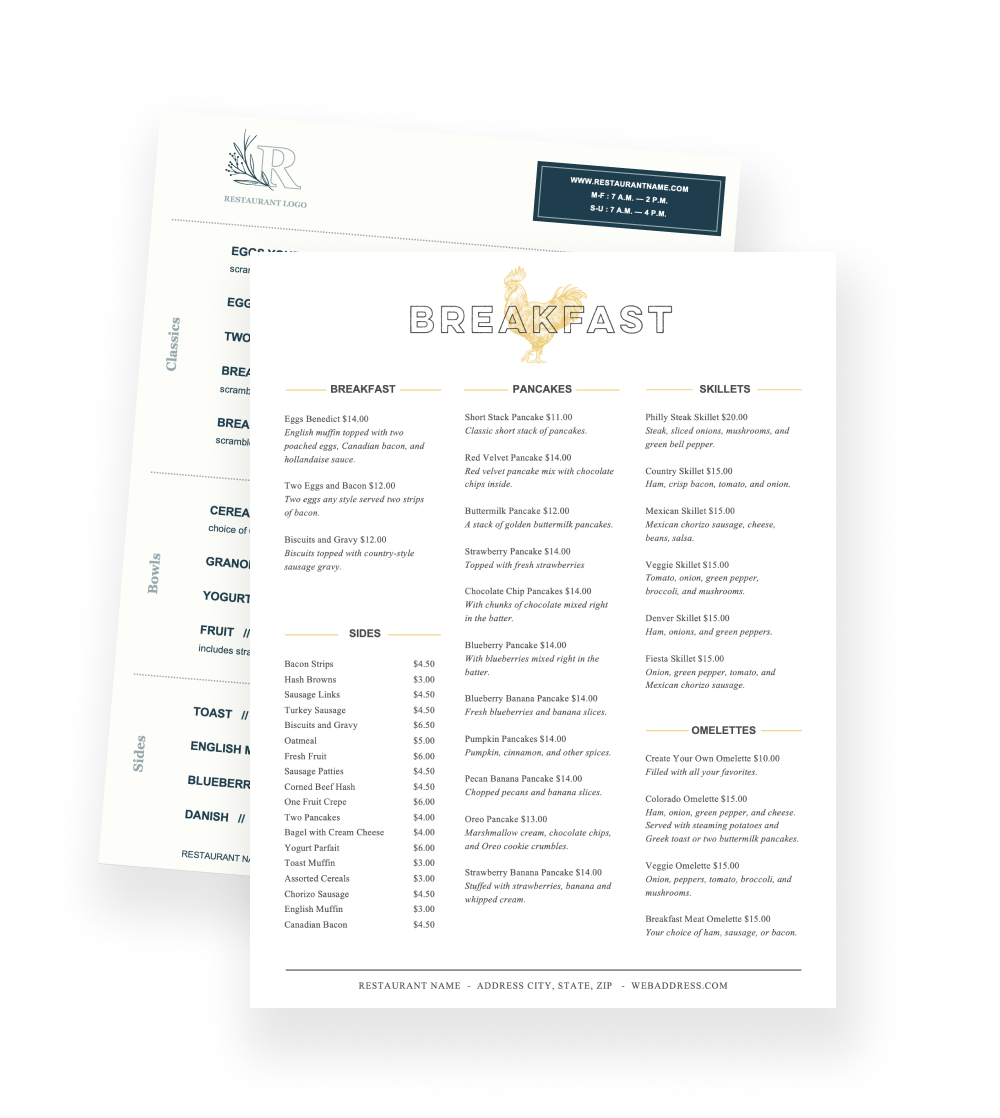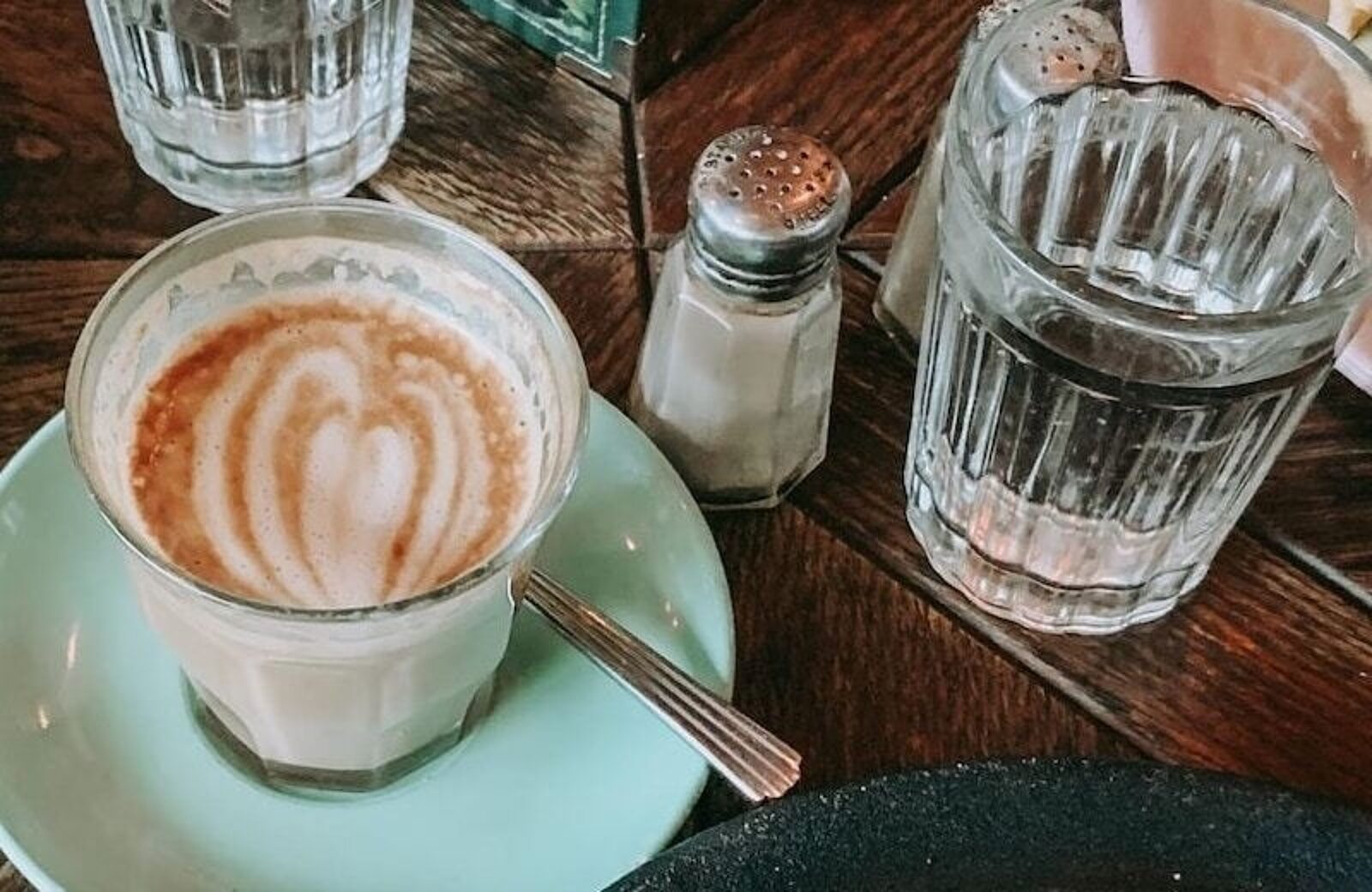
How to Make a Brunch Menu Design With Examples (Free Template)
This is everything you need to know to develop, engineer, and design your perfect brunch menu.
Debbie MillerAuthor


Breakfast Menu Templates
Use these breakfast menu templates as a starting point for your menu design or to give your menu a refresh.
Get free downloadA well-designed brunch menu is an asset for any restaurant. It represents your brand and helps entice diners. A standout brunch menu should appeal to a broad audience, mesh well with the restaurant’s cuisine, and maximize profits wherever possible.
Let’s explore the essential components of crafting a captivating brunch menu, both in the physical space of your restaurant and online. From menu design to pricing and descriptions, we’ll provide actionable insights to create a menu that appeals to both brunch-goers and your bottom line.
This is everything you need to know to develop, engineer, and design your perfect brunch menu.
The Power of Good Restaurant Menu Design
Your menu is not merely a list of dishes; it’s an extension of your brand. Your restaurant brand is an essential part of how your guests perceive your business and feel during their dining experience. Plus, when you’re an establishment that offers varied brunch, lunch, and dinner options, you can really have fun and get creative with your branding.
Your brunch menu is a powerful tool that influences customer decisions and helps drive sales. Start with menu engineering – the art of strategically designing menus to increase sales and maximize profits. The goal? Harmonize costing and pricing information with your restaurant vibes and brand.
By understanding the psychology behind menu design, you can leverage the following categories to enhance your brunch menu:
Layout and Organization: Arrange your menu items in a logical and visually appealing manner, considering the flow of information and highlighting popular choices or specials.
Visual Cues: Utilize images and symbols to provide visual representation of menu items, making it easier for everyone to understand and choose their meals.
Descriptive Language: Craft compelling menu descriptions that highlight the unique features and benefits of each dish.
How to Make a Brunch Menu
Creating an engaging brunch menu requires attention to several key elements. Let's explore each step in the process:
Write Out All Menu Items
Start by taking note of every single item that will go on your menu. Then, home in on popular dishes that cater to more casual tastes. Think eggs, bacon, sausage, pastries, pancakes, waffles, etc.
Beyond your standard list of brunch-favorite food and drinks, are there any specials or deals you can include? Certain drinks or food items that are only available during brunch hours? Be sure to also include a variety of options, like vegetarian or allergy-friendly choices.
Categorize Menu Options
After you’ve narrowed down what you’ll offer, it’s time to assess how to best organize everything in your menu template. Group menu items into clear categories. "Main Courses," "Sides," "Beverages," and "Desserts" are basic examples to facilitate navigation.
How will you make high-price items stand out to drive revenue? Will sides like bacon and sausage be included with waffles, or will they be separate? Will the most expensive dishes go first? A menu engineering worksheet can be super helpful in outlining categories.
Set Menu Prices
A whopping 45% of diners go out to eat multiple times a week, with another 20% going out to eat once a week. How can you stay competitive and keep your loyal customers coming back? The key is to determine pricing that strikes a balance between affordability and profitability. Consider offering meal deals or combo options to incentivize ordering.
A restaurant menu pricing strategy is critical for operators looking to be intentional about their profitability. You must keep tabs on consumer habits and wage trends, to name a few. Craft a menu strategy that ties into navigating inflation and protecting profitability.
Create Menu Descriptions
When deciding how to position your offerings, put yourself in your customer’s shoes and imagine what would make dishes stand out to. Figure out how to present menu items in a way that feels aligned with your overall vibe.
The best place to start? Craft concise and appealing descriptions for each item. Use language that evokes imagination and appetite. Highlight any unique features or ingredients that set your menu apart.
For example, rather than just listing “eggs,” say “fluffy egg whites seasoned with salt and pepper.” Use descriptors that are vibrant and that diners can “taste.” You can also be quirky with your brunch to show personality and avoid generic verbiage.
Decide on a Menu Color Scheme
Visuals also play a major role in menu design. Choose colors that resonate with children and reflect your brand identity. Consider brand colors as a starting point, then get creative from there. Chron’s The Psychology of Colors for Restaurant Designs is a great resource for exploring design options.
Design your Brunch Menu
Design a visually appealing menu layout that is easy to read and navigate. Consider using playful fonts and graphics that align with your target audience. Colors can make a huge difference and allow you to lean into your restaurant’s brand.
Not sure where to start? Check out our free menu templates for inspiration. There are lots of other tools and resources like Adobe Suite, Canva, or Pinterest that can help, too.
Think About Photos
Allowing your customers to put a “face” to their food can be helpful. High-quality, appetizing food photos can entice diners to try new dishes.
Include images strategically and ensure they accurately represent the menu items. Dive into menu design best practices that can be helpful for any establishment looking to deliver a top-tier menu.
Choose Menu Fonts, Spacing, Composition, and Layout
You have a color scheme, a general idea of how you want your menu items to be laid out on the page, and possibly a few photos you want to include. Now, it's time to put it all together to create a restaurant menu.
Use clear and legible fonts, appropriate spacing, and a balanced composition to enhance readability and create a cohesive visual experience. Test different menu layouts to determine the most effective one.
For example, do your diners prefer a simpler menu or one with a more vibrant personality? Or a combination of both? Seek feedback from your staff, focus groups, or conduct A/B testing to optimize the design.
Proofread Your Menu
Thoroughly proofread the final menu for any errors or inconsistencies. One misplaced comma or small typo could change your guests' perception of the restaurant.
Ensure that all menu items, descriptions, and prices are accurate and up to date. According to our Restaurant Success Report, 31% of restaurateurs update their menu on a monthly basis and 24% do it seasonally. Make sure your customers aren’t ordering from outdated menus since that can lead to disappointment and a poor customer experience.
Restaurant Menu Templates
Use these menu templates as a starting point for your menu design or to give your menus a refresh.

5 Great Brunch Menu Examples
Café Nunez – New York, NY
Café Nunez goes for a clean, simple menu with a dark background to make the text and photos pop. The images are aligned evenly to the left of the text, which is concise and allows guests to easily make a decision. The overall vibe ties into the restaurant’s general branding and incorporates their social media channels at the bottom.
The Table – Deland, FL
The Table went for a light, airy, photo-less brunch menu. There are no photos, but rather, a diversity in fonts and font sizes to make certain aspects pop. For example, the self serve waffle bar is larger and circled, while the mimosa box is also highlighted. They also use cute titles like “weekend remixes” and “talk mimosa to me” to show their personality.
Zingarella’s – Plantsville, CT
Zingarella’s takes an opposite approach by incorporating loud, punchy colors into their Sunday brunch menu. While they don’t have any photos, the fonts and color schemes convey a fun, feminine vibe.
Daily Menu – Richmond, VA
In contrast to the lighter options noted, Daily Brunch goes for a dark background with light text to tie into their overall brand. They also incorporate a frame and some varied visual aspects, like food photos as well as comic-looking beverage photos. The bubbles in the background add some additional dimension, too.
Ayhan’s Mediterranean Marketplace Café – Port Washington, NY
Ayhan’s approach is more varied in that all their menus look completely different from each other. The brunch one specifically has a woodsy-background with some bright colors to pop at the top. Square food images line the right side to give diners an idea of their options. All menu items are clearly defined to provide lots of detail to customers.
Designing a captivating brunch menu goes beyond just listing food options. By incorporating effective menu engineering techniques and thoughtful design elements, you can create a menu that not only appeals to a wide audience but also represents your brand and drives profitability.
Remember to regularly evaluate and update your brunch menu based on customer feedback and changing trends. Ensure it remains fresh, exciting, and relevant to diners and their families.
Is this article helpful?
DISCLAIMER: This information is provided for general informational purposes only, and publication does not constitute an endorsement. Toast does not warrant the accuracy or completeness of any information, text, graphics, links, or other items contained within this content. Toast does not guarantee you will achieve any specific results if you follow any advice herein. It may be advisable for you to consult with a professional such as a lawyer, accountant, or business advisor for advice specific to your situation.
Read More
Subscribe to On the Line
Sign up to get industry intel, advice, tools, and honest takes from real people tackling their restaurants’ greatest challenges.



